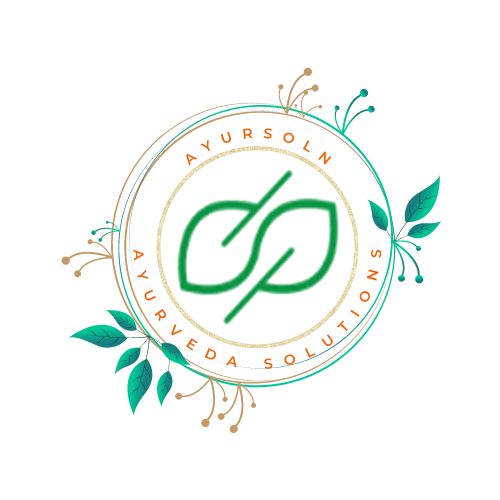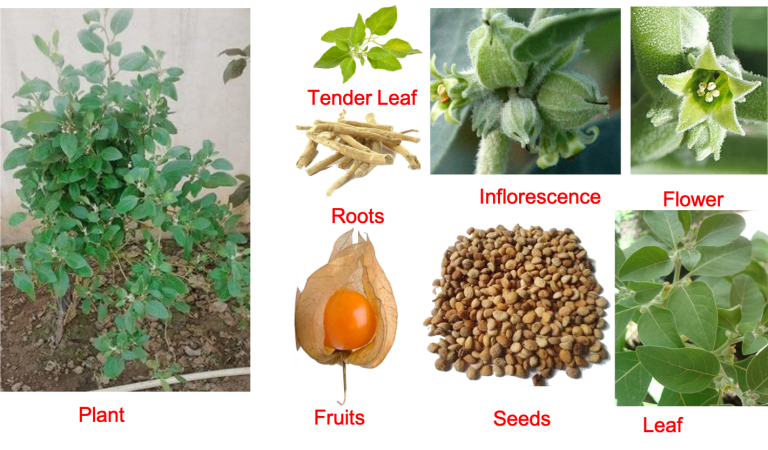ASHWAGANDHA
- Home / DRAVYAGUNA (AYURVEDIC PHARMACOLOGY) / / KNOW ABOUT MEDICINAL PLANTS / / AYURVEDIC MEDICINAL PLANTS /
- ASHWAGANDHA
Ashwagandha is a plant that is considered to be having many medicinal benefits as per Ayurveda. The benefits are also researched and have been proved to be viable even today. This makes it all the very important too. The plant is famously known as Indian Ginseng. The botanical name of the plant is Withania somnifera (Linn) Dunal and belongs to the family of Solanaceae. The name Withania refers to to the name of the scientist “Withan” while the name Somnifera is denoting the effect of “inducing sleep”. The plant is usually seen throughout India upto an elevation of 5000 feet. It is usually found as weeds in the dry regions of India. The details of the plant are as described below.
PLANT DETAILS
BOTANICAL NAME
Withania somnifera (Linn) Dunal or Physalis flexuosa L.
FAMILY
Solanceae
NOMENCLATURE
VERNACULAR NAMES
- Kannada – Angara beru or Ashwagandha
- Malayalam – Amukkuram
- Tamil – Amukkira
- Telugu – Ashwagandha
- Hindi – Asgandh
- English – Indian Ginseng or Winter Cherry
SANSKRIT SYNONYMS
- अश्वगन्ध (Ashwagandha), वाजीगन्ध (Vajigandha), हयगन्ध (Hayagandha – The roots have the smell similar to that of the horse
- कम्बुकाष्टा (Kambukashta) – A woody part which is tubelike.
- वराहिक (Varahika), वराहकार्णी (Varahakarni) – The leaves are like that of the ears of pig
- तुरगी (Turagi), वाजिनी (Vajini), हयी (Hayi) – The smell of the roots are similar to that of the horse
- वनज (Vanaja) – Sweet taste of the root
- पुष्टिदा (Pushtida), बलद (Balada) – Highly nutritional
- पुण्य (Punya) – The plant is meritorious
- पीवरी (Pivari) – The seeds are flattened in shape.
SAMHITA CLASSIFICATION
- Charaka Samhita – बल्य (Balya), बृंहणीय (Brimhaneeya), मधुरस्कन्द (Madhuraskanda)
NIGHANTU CLASSIFICATION
- Dhanvantari Nighantu – Guduchyadi Varga
- Bhavaprakasha Nighantu – Guduchyadi Varga, Astavarga pratinidhi in Hareetakyadi Varga,
- Raja Nighantu – Shatahvadi Varga
- Kaiyadeva Nighantu – Aushadhi Varga
BRIEF MORPHOLOGY
An undershrub which is branched that grows upto 2 to 4 feet height. It is usually clothed with stellate tomentose. The leaves are ovate, simple, alternate, hairy about 5-10 cm long and 2 to 5 cm broad. The inflorescence is Umbellate cymes that arise from the base of the leaves. The flowers are greenish or light yellow in colour. The fruit is a berry, red in colour, small, round, juice, capsulated by the 5-angled inflated calyx. The seeds are small, slimy and flat. The roots are long, tapering, light brown in colour or grey from outside and white inside. The tender or wet roots smell like that of horse.
PHARMACOGNOSY OF OFFICIAL PART
MACROSCOPY
YET TO BE COMPILED
MICROSCOPY
YET TO BE COMPILED
PART USED AND POSOLOGY
PART USED
मूल (Roots), क्षार (Alkalie)
DOSE
चूर्ण (Powder) – 3 to 5 gms, क्षार (Alkalie) – 1 to 3 grains
PHYTOCHEMISTRY
The roots contain an alkaloid withoniol, somniferin, phytosetrols like withaferins, etc. Even the aerial parts yields 5-dehydroxy withanolide-R and withasomniferin-A. It als ocontains sugars, gum, resin and different dyes.
रसपञ्चक कर्म PROPERTIES AND USES AS PER AYURVEDA
गुण (Properties)
- रस (Rasa) – मधुर (Madhura), कषाय (Kashaya), तिक्त (Tikta)
- गुण (Guna) – गुरु (Guru), स्निग्ध (Snigdha)
- वीर्य (Veerya) – उष्ण (Ushna)
- विपाक (Vipaka) – मधुर (Madhura)
- प्रभाव – None
कर्म & प्रयोग (Action & Indications)
- दोषकर्म (Doshakarma) – कफवातशामक (Kaphavatashamaka)
- धातुकर्म & मलकर्म (Dhatukarma and Malakarma) – Main actions – बल्य, रसायन, अतिशुक्रल, कुष्ठघ्न, व्रणरोपण (Balya, Rasayana, Atishukrala, Kustaghna, Vranaropana)
- Other Actions – रक्तशोधक, अनुलोमन, क्रिमिघ्न, हृद्य & दीपन (Raktashodhaka, ANulomana, Krimighna & Deepana)
- प्रयोग (Prayoga) – Mainly कास, श्वास, शोष, वातव्याधि, श्वित्र, शुक्रदौर्बल्य & कार्श्य (Kasa, Shwasa, Shodsha, Vatavyadhi, Shwitra, Shukradaurbalya & Karshya), also useful in शूल, उदरविकार, शोथ, ग्रन्थि, गलगण्ड, भ्रम, व्रण, etc (Shula, Udaravikara, Shotha, Granthi, Galaganda, Bhrama, Vrana, etc)
AYURVEDIC FORMULATIONS
CLASSICAL
- अश्वगन्ध चूर्ण
- अश्वगन्ध रसायन
- बलाश्वगन्ध तैल
- अश्वगन्धारिष्ट
- महारास्नादि क्वाथ
PROPRIETARY
- Action capsule (Astanga Ayurveda)
- Albisciss capsule (Albia biocare)
AGRONOMY
ENVIRONMENT
The plant prefers semi-tropical areas with a preferred altitude is 600 to 1200 mts above sea level. The preferred temperature is 25-35 deg C with an average rainfall of 500-750mm. Late winter rains are conducive for root development. It also requires dry season during its growing period.
CULTIVATION
Needs a Sand loam or light red soil with alkaline pH between 7.5 to 8. The seeds are sown directly in ploughed fields or in the nursery beds. Those sown in nursery beds are transplanted to soil after 25 to 35 days. Light shower of water ensures better growth. Excess of water or rainfall should be avoided. Irrigation is to be done once in 10 days. The planting is done during August/September where the flowering occurs in December and the crop attains maturity in the month of January or February. The total duration is 190 days for the plant to attain maturity and become ready for harvest.
HARVESTING
Maturity is judged by drying of leaves and emergence of red berries. Harvesting is done by digging out the whole plant with the roots carefully without damaging it. The roots are then cut transversely into small pieces. They are beaten with clubs so that the mud adhering them along with brittle rootlets are removed. The roots yield is around 1.2 to 2 quintals per acre, while the seeds yield from 2 to 3 kgs per acre.
STORAGE
The harvested roots are cut into small pieces to a length of 7-10cms, dried and then stored in airtight containers.
VARIETIES AND SUBSTITUTES OR ADULTERANTS
VARIETIES
NONE MENTIONED
ADULTERANTS
NONE MENTIONED
SUBSTITUTES
YET TO BE COMPILED
TOXICITY
TOXIC SYMPTOMS
- YET TO BE COMPILED
ANTIDOTE
- YET TO BE COMPILED
शोधन or PURIFICATION METHOD
- YET TO BE COMPILED
THERAPEUTIC USES
EXTERNAL USES –
A fomentation of the leaves is used for sore eyes, boils and swollen hands and feet. A paste of leaves in locally applied to kill lice infesting the body and over carbuncles and syphilitic sores. The leaves are applied to tumours and to tuberculous glands. The green berries are rubbed agains ringworm infections in both human beings and animals. The application of paste made from leaves is useful in the treatment of erysipelas and haemorrhoids.
INTERNAL USES –
The decoction of roots are given internally to treat Rheumatic disorders and arthritis. It is also advised to be given in dyspepsia. The infusion of the bark is useful in the treatment of Asthma. The roots in the form of powder or decoction is given internally to treat general debility, loss of appetite, as tonic and aphrodisiac.
CONTROVERSY (IF PRESENT)
YET TO BE COMPILED
LIST OF RESEARCH STUDIES
- Singh, Narendra et al. “An overview on ashwagandha: a Rasayana (rejuvenator) of Ayurveda.” African journal of traditional, complementary, and alternative medicines : AJTCAM vol. 8,5 Suppl (2011): 208-13. doi:10.4314/ajtcam.v8i5S.9
- Chandrasekhar, K et al. “A prospective, randomized double-blind, placebo-controlled study of safety and efficacy of a high-concentration full-spectrum extract of ashwagandha root in reducing stress and anxiety in adults.” Indian journal of psychological medicine vol. 34,3 (2012): 255-62. doi:10.4103/0253-7176.106022
- Langade D, Kanchi S, Salve J, et al. (September 28, 2019) Efficacy and Safety of Ashwagandha (Withania somnifera) Root Extract in Insomnia and Anxiety: A Double-blind, Randomized, Placebo-controlled Study. Cureus 11(9): e5797. doi:10.7759/cureus.5797
The video on Ashwagandha emphasises on the various aspects of the plant especially with respect to its cultivation and its characteristics for identification such that they are preserved for the future generations.



